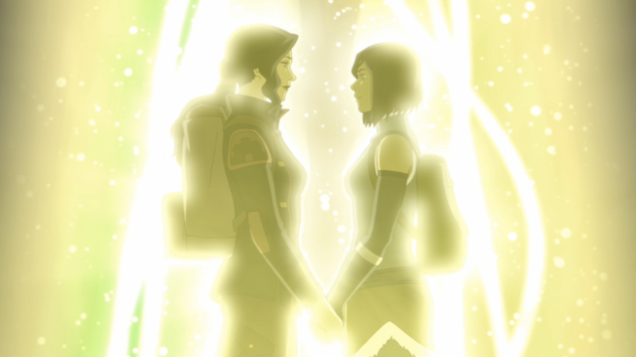“You can celebrate it, embrace it, accept it, get over it, or whatever you feel the need to do, but there is no denying it.”
That is what creator Bryan Konietzko posted on his blog shortly after the season finale of acclaimed series “The Legend of Korra,” where in the last few minutes the titular heroine hooked up with Asami, her best friend who also happened to be female.
Konietzko wrote about how he and co-creator Michael Dante DiMartino figured they wouldn’t be allowed to make that final scene; not because they had asked and were shot down, or because Nickelodeon expressly forbade LGBT relationships beforehand. No, they assumed it wasn’t going to happen because it never had – no children’s cartoon in the U.S. ever had even one openly LGBT character before, let alone two in a relationship.
To be fair, there have been characters that were LGBT in cartoons – we just didn’t know it, because it was never spoken of. Only afterwards in interviews or personal websites would the writers and creators of famous kid’s shows such as Greg Wiseman, creator of “Gargoyles” and Dwayne McDuffie, creator of “Static Shock,” revealed that major characters in the series had been gay all along.
These revelations were not unlike J.K. Rowling’s revelation that Dumbledore had been gay – neat, but so what? If it didn’t affect the plot, wasn’t ever brought up in any way and could otherwise be easily ignored without changing a thing, what was the point of making them other than straight? Gays and lesbians would love more representation of themselves, but if your character’s orientation is little more than a footnote written years later, it’s not really a representation, is it?
This lack of representation continues even today. The writers of Adventure Time have gone on record that two of their prominent female characters used to be together, but are doubtful they’ll ever bring it up in the show proper. Konietzko and DiMartino, despite their daring move, are still guilty of this same issue – they have since revealed that two other characters in “Korra” were homosexual, and like the above examples this was never mentioned in the show proper. Konietzko admitted that the actual coupling still falls short – it’s at the very end, it’s only implied (albeit heavily) and the couple doesn’t even kiss – but considers it a small step forward and hopefully an inspiration for others to take it further.
Thankfully, that is exactly what has happened. The new animated show “Clarence,” about the average life of a young boy, has a major supporting character with two moms. Perhaps more prominently, popular cartoon “Steven Universe” has a main protagonist named Garnet, an alien being that is the fused form of two female aliens that love each other so much they merged into one. She’s a personification of a homosexual relationship made physical. There’s nothing subtle about it either; not only has show creator Rebecca Sugar confirmed the relationship as romantic, the episode revealing Garnet’s true nature also comes with a song sung by Garnet about how she is quite literally made of a loving relationship, and how wonderful that is. The song can be seen here: https://www.youtube.com/watch?v=0q-RSGsTI-0.
It’s been a long, slow road, but there are finally open LGBT characters in cartoons that kids in the real world can relate to. While there is still room for improvement – the aliens in “Steven Universe” are technically genderless and only look like women, and none of these characters in any program have been seen kissing on the lips – it is more likely today than just a few years ago that LGBT relationships will be just as prevalent and ordinary as straight relationships already are on children’s programing. And greater inclusiveness to all loving orientations is a good thing. There’s no denying that.




